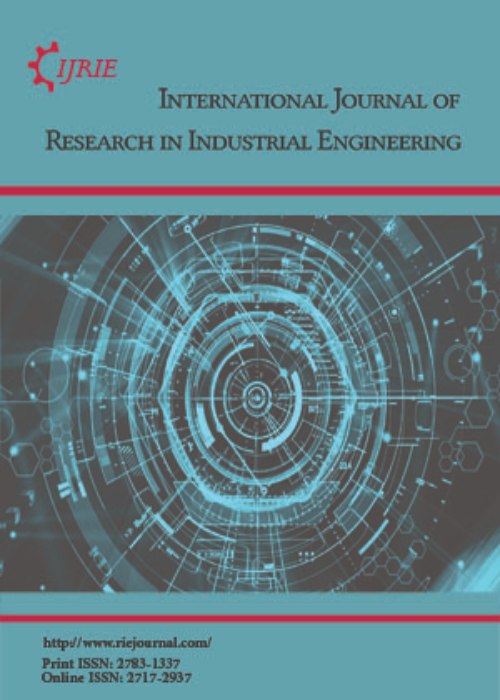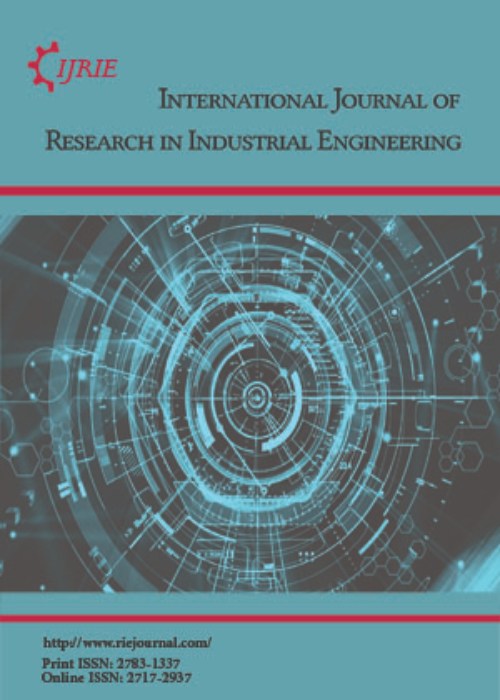فهرست مطالب

International Journal of Research in Industrial Engineering
Volume:12 Issue: 1, Winter 2023
- تاریخ انتشار: 1402/01/07
- تعداد عناوین: 7
-
-
Pages 1-6Industrial Engineering degree curriculum has many courses - Supply Chain Management, Production Planning and so on. However there is need to introduce new course in Industrial Engineering degree curriculum - Creative Industrial Engineering. This course will be designed by Industrial Engineering teachers who have taken extensive and intensive training in Creative Thinking, Design thinking, Lateral thinking etc. They will apply the principles learnt in Creative Thinking, Design Thinking and Lateral Thinking to the problems of Industrial Engineering.It is high time we introduce Creative Industrial Engineering so that Industrial Engineering can apply itself to problems not conventionally considered as part of Industrial Engineering.This will make Industrial Engineering step out of its comfort zone and get into down to earth commonsense problems faced by every one and provide solutions that require lateral thinking, creative thinking, out of box thinking, divergent thinking, right brain thinking . The course content can differ from each institute to another teaching industrial engineering. There has to be a greater discussion amoung academicians of the feasibility of this course, since its need is without doubt unquestionable.Keywords: Industrial engineering, creative, Education
-
Pages 7-20A multi-product system is one of the different types of manufacturing systems, in which a large number of products are produced that complement each other and have interdependence. These types of systems have recently been widely used in various industries. In some types of multi-product manufacturing industries that offer their products as a package, the scheduling of the production of components of each package affects the time it takes to complete the package. Therefore, a new problem has been defined that the primary purpose of its production scheduling, in addition to reducing the completion time of the products, is to make various items forming a package, get ready over a short interval of time and be supplied to the sales unit so that the package can be delivered to the final consumer. The purpose of this paper is to express the problem of production scheduling of multi-product production systems in the form of linear programming. For this purpose, two mathematical models are presented, and their functions are compared. Besides, an efficient genetic algorithm is proposed to solve the problem, which is able to solve the problem in a reasonable time, with acceptable accuracy.Keywords: Parallel Lines Production Scheduling, Operations Sequence, Mixed-integer linear programming (MILP), Genetic algorithm (GA)
-
Pages 21-42The Aircraft Scheduling Problem (ASP) refers to allocating each aircraft to the optimal take-off and landing time and the appropriate runway. This problem is the allocation of aircraft to the desired runway so that the total damage due to delays or haste in landing or take-off of all aircraft is minimized. Runway allocation, landing and take-off sequences, and scheduling for each aircraft must be done in a predetermined time window. Time should also be considered as the time of separation between landings and take-offs due to the wake vortex phenomenon. In general, the purpose of such problems is to make maximum use of the runway. Therefore, in this study, a mathematical model of robust landing and take-off scheduling at an airport is provided, assuming no access to the airport runway at certain times. Moreover, delays and haste in landing and take-off on the runway, limited access to aircraft, runway repair time, and the possibility of runway disturbances are investigated. Robust optimization is used to deal with uncertainty at take-off and landing times. Finally, Genetic and Imperialistic Competitive Algorithm are used to evaluate and analyze the problem because it is NP-HARD problem. The results indicate the ability of the proposed algorithms to find high-quality solutions in a short computation time for problems up to 7 runways and 60 aircraft.Keywords: Aircraft Scheduling Problem, robust optimization, Genetic Algorithm, Imperialistic competitive algorithm
-
Pages 43-52In welded constructions, there should be no defects in the welding seams, or defects should have in an acceptable range for obtaining more reliable welding operations. An undercut is one of the most important welding defects occurring on the workpieces produced by butt welding. Determining the correct value of the stress concentration factor (SCF) allows deciding whether it accepts welding defects, in which case. Many characteristics and ranges influence SCF, making it challenging to calculate a more precise SCF. In this study, six different artificial neural networks (ANN) models are developed for predicting SCF. These models differ in terms of the training dataset used (70%-90%) and the number of neurons (5-10-20) in the hidden layer. Developed ANN models consist of three input variables the ratio of Undercut depth (h) and Undercut deep Radius (r), Reinforcement angle (Q1), deep angle of welding seam (Q2), and an output variable as SCF. The prediction performance of 6 developed ANN models in different specifications is compared. The model with a 90% training set and five neurons in the hidden layer performed the best with an accuracy of 0.9834. According to the ANN model with these features, MAE, MAPE, and RMSE values are calculated as 0.0094, 2.50%, and 0.0129, respectively.Keywords: Welding defects, Stress Concentration Factor, Artificial Neural Networks
-
Pages 53-72Congestion is one of the important concepts in data envelopment analysis that occurs when excessive inputs reduce the maximally possible outputs. Identification and elimination of congestion have a significant impact on reducing inputs along with increasing outputs. Hence, various studies have been conducted to detect and evaluate congestion. However, in today's world, no organization can achieve its final output with just one process of input. In other words, today's organizations have a network structure that consists of several subsections. Ignoring the existing influences among the subsections processes may lead to inadequate or even incorrect results for evaluating the congestion. While all of the existing methods only evaluate the congestion of each subsection or the whole system independently. Therefore, in this paper, the concept of congestion is developed for a specific and so practical case of network structure called “two-stage network structure”. This case of network structure consists of two series stage such that stage 1 consume some primary inputs to produce some intermediate outputs. In the following, the intermediate outputs are used as the inputs of stage 2 to produce the final output. Here, the concept of congestion is defined for systems with a two-stage structure. Then, to examine the congestion of each stage as well as the congestion of the whole system, a single linear programming model is proposed. The validity of the proposed model is investigated using several theorems and it is shown that the new definition is a generalization of the previous definitions of the congestion for the black-box systems. Finally, the proposed model is applied to a case study including 24 non-life insurance companies in Taiwan.Keywords: Network Data Envelopment Analysis, Two-stage network structure, Intermediate output, Congestion
-
Pages 73-87Due to the importance of environmental effects of manufacturing system in recent decades, the production systems are obliged to comply different environmental regulations. The present research, aims to design a green supply chain model for Guilan steel industry with a hybrid approach. This study is applied research in term of purpose, exploratory in term of method, quantitative and qualitative in terms of data type. A researcher made questionnaire are applied, in addition to interview, for data gathering. The under-study research population includes steel industry experts out of them, 12 experts were selected for data gathering phase. Conducting the research, first applying fuzzy Delphi method, 5 main factors and 25 important sub-factors were identified. Then, using fuzzy DEMATEL and interpretive structural modeling (ISM) methods, the importance of each facto was determined, in which two factors "external environment study" and "internal environment study" were at the highest level of the importance, while "Waste reduction", "waste recycling" and "purchasing based on environmental products" were at the last level. These variables are interrelated and affect their next levels.Keywords: Green supply chain, Delphi method, fuzzy Dematel, ISM
-
Pages 88-105This study aims to identify and prioritize the effect of technology capability drivers on the supply chain performance of automotive companies. Technology capability indicators are ranked and prioritized using the fuzzy hierarchical analysis technique. The research method is applied in terms of purpose, is described as the data collection method, and is considered quantitative research. After reviewing the theoretical literature of the research, the drivers of technology capability on the organization's performance were identified for prioritization; they were weighed by a number of experts in the field of automotive companies using questionnaires and fuzzy hierarchical analysis. Indicators and sub-indices of variable technology capability were ranked and prioritized. Based on the results of this research model, it was found that of the eight indicators examined, "strategic technology capability", "product technology capability", and "supplier technology" was the most important, and of the 38 technology capability sub-indicators examined, "Technology Development" is the most important.Keywords: Technology capability, Organization performance, Supply chain, Iranian Automotive Industry, Fuzzy hierarchical analysis


